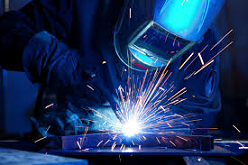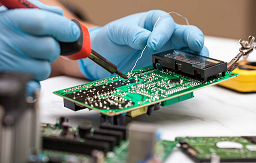Welding and soldering are common in the automotive industry, electronic industry, construction industry, and mechanical industry, etc. therefore, it is important to understand the difference between these processes. Let us begin by learning the main difference between these fabricating processes and move on to break down their advantages and disadvantages.
Welding Vs. Soldering –What’s the difference?
Welding and soldering are both fabricating techniques i.e. they are used to bond metal materials together with the help of certain equipment and input. Here below are the key differences between welding and soldering.
Strength – Welding joints are stronger in comparison to soldering joints. Temperature – Different metals require different temperatures to melt and create a bond. Steel variant is usually used in welding which may require a temperature between 3,000 degrees Celsius and 20,000 degrees Celsius. Soldering, on the other hand, will require roughly 350-450 degrees Celsius. Heating – Base metals in the welding process are heated to melt and create a strong bond, whereas, in soldering, base metals require no heating or melting. Metal Properties – In welding, the base metal changes its mechanical properties due to cooling and heating. Base metals do not have a significant effect on their mechanical properties in soldering. Heat Treating – Heat treatment is the process where metal’s physical and chemical properties are altered by heating and cooling it back. This is common in welding techniques, but not in soldering. Skills Requirement – A Welder and a soldered are both professional workers who require skills and experience in their assigned job. A welder can be commonly found in the automotive, manufacturing, and construction industry. A soldered works mainly in the electronic industry. Preheating – Soldering requires preheating of work pieces but, no preheating of work pieces is required in the welding process.
Common types of Welding and Soldering techniques –
Welding:
Gas Metal arc Flux Cored arc Shielded Metal arc Gas Tungsten arc
Soldering:
Brazing Silver Soldering Resistance Soldering Induction soldering Electronic components
Let us now understand what welding and soldering exactly is plus, we shall also discuss what advantages and disadvantages each technique carries.
About Welding
Brazing vs soldering Soldering iron vs soldering gun Soldering aluminum How to solder copper pipe What is a solder mask
In the simplest terms, welding can be defined as a technique to join metal parts by heating and melting touching parts at a certain point and cooling it down to become a rock-solid bond. The base metals are heated to melt, this changes the metal’s properties and therefore results in a strong joint. Talking about complexity, welding is more complicated than soldering and requires more technical knowledge as it involves the use of gases, flames, and electricity that needs to be regulated. In this technique, metals can be either of the same property or different, plus it involves the use of equipment to carry out the task. The temperature hugely depend on the type of metal being welded and type of welding but, typically it is around 3000 degree Celsius and in some cases, much hotter.
Types of Welding:
Welding can be categorized into two main categories: Arc Welding – It involves the use of electricity to heat and melt the base metal. They can be further classified into the following categories.
Shielded metal arc MIG welding TIG welding EGW welding
Torch Welding – It involves the use of fuel gases and oxygen to heat and melt the base metal.
Advantages and Disadvantages of Welding
Welding creates joints when the base metal is heated, melted, and cooled back again, however, it comes with its own pros and cons, let’s see:
Advantages:
Welding creates a permanent bond/joint. This technique creates the strongest bond in comparison to other techniques. You don’t need to drill a hole on parent parts to weld. Because there is no hole, the load-carrying capacity of the output becomes unmatchable. You can weld dissimilar metals and of various sizes and shapes.
Disadvantages:
Skilled labor and top functioning equipment are required. Uneven cooling and heating can result in residual stress within the welded assembly. Inspection of air pocket, penetration, and slag inclusion is difficult. Welded joints are prone to vibration.
About Soldering
Soldering is a technique or a process to bond metals with the help of solder. Solder is a metal alloy with a low melting point and is often regarded as the base metal for soldering. The piece or structure that is being bonded together does not get hot enough to melt and this is where solder (base metal) comes into play and creates the connection. As the melting point of base metal is low, the temperature required in this technique does not exceed 448 degrees Celsius. That being said, the temperature can vary depending on the metal and the type of work you are doing. Soldering is common in the electronic industry and has a huge contribution to bonding electric components. It is also used in other applications like jewelry making and plumbing etc.
Advantages and Disadvantages of Soldering
Soldering is an essential technique in various industries and comes with its own advantages and drawbacks. Let us see in detail.
Advantages:
Soldering can be operated at low temperatures. Dissimilar base materials are easy to join. Residual stresses on the joint are low. It is not a time-consuming process. Soldering is easy to operate and does not require high labor skills.
Disadvantages:
The load-bearing capacity of joints is not quite strong. Soldering is not suitable for assembling large structures. Fluxes used in the soldering process could be toxic.
Welding vs. Soldering: Comparison chart
Difference between Welding and Soldering
Here below are some categories for differentiating welding and soldering. 1: Melting temperature of additional material – In soldering, the temperature is less than 450 degrees Celsius which is somewhere around the melting temperature of base metal. In welding, it is more than 450 degrees Celsius. 2: Use of flux – Flux is a chemical purifying agent that aid in the soldering process. This agent is optional in the welding process. 3: Heat source – In welding, common sources of heat are electric current, plasma, electron beams, and electric arc. In the case of the soldering process, heat sources are ultrasound, oven, electrical resistance, and soldering iron. 4: Deformation – In the welding process, the material goes through physical as well as chemical changes. In soldering, the degree of deformation is quite low. 5: Remaining strains – The welding process has a high chance of remaining strains, but this is not the case in the soldering process.
Summary of Welding vs. Soldering
Welding is a process of joining identical or dissimilar metals with the help of equipment and additional material. They are divided into two main categories – Arc welding and Torch welding. Joints created by welding are very strong and have a high load-bearing capacity. This technique is widely used in the construction, automotive, and mechanical industries. Soldering is a process of joining similar or dissimilar metals with the help of solder. The base material used in soldering is a solder (metal alloy) as it has more melting point than the additional materials. The soldering technique is common in the electronic industry. This technique is easy to operate and is less time-consuming.
Comment * Name * Email * Website
Δ







![]()